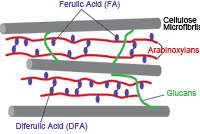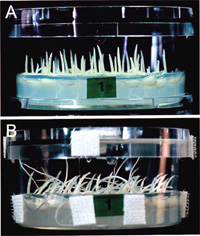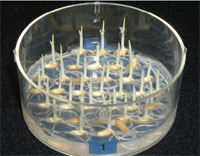This is an archive of information released in the past.
Disclaimer: It may contain broken links or outdated information. Some parts may not function in current web browsers.
*Visit https://humans-in-space.jaxa.jp/en/ for the latest information.

Experiment
- News
- Kibo Utilization Strategy
- Kibo Utilization Plan
- List of JAXA's Utilization Themes
- Experiment Facilities
- Space Environment Utilization
- Archive
News
- Experiment Completed (June 4, 2010)
Background

Figure 1. A schematic model of cell walls of gramineous plants
After plant ancestors migrated from sea to land, they have been directly exposed to the gravitational force of 1g. Plants have developed the cell wall to support and stand upright their body against the gravitational force at 1g, as do the bones and muscles in an animal body. The plant cell wall has many functions, such as the provision of strength and shape to the cell and of rigidity to the whole plant, the control of cell growth, the protection from attack by pathogens and predators, and the transportation of water and nutrients. Thus, cell wall is an essential organelle in plant life cycle.
In the present study, we investigate the changes in cell wall structure of rice shoots under microgravity conditions in space. The polysaccharide composition of the cell wall in gramineous plants, such as rice, maize, wheat, and barley, is distinguished from that in dicotyledons, such as Arabidopsis, pea, and mung bean, which have been used in many space experiments.
In the cell wall of dicotyledons, xyloglucans are the major matrix polysaccharides and tether cellulose microfibrils. In contrast, gramineous plants contain only small amount of xyloglucans.
Arabinoxylans and glucans are the major matrix polysaccharides in the cell wall of gramineous plants and they make network structure between cellulose microfibrils. Particularly, arabinoxylans possess phenolic compounds, such as ferulic acid (FA). FA undergoes a peroxidase-catalyzed coupling reaction to produce diferulic acid (DFA), which cross-links arabinoxylan molecules. Thus, the formation of arabinoxylan-DFA cross-links makes a rigid network between cellulose microfibrils. We assume that the gravitational force affects the level of arabinoxylan-DFA network in cell walls of gramineous plants.
Objectives

Figure 2. The Morphology of Rice Seedlings
How will ferulate change in space ?
The objective of this study is to clarify the effect of microgravity on the formation of arabinoxylan-DFA network in rice shoots. We assume that the levels and composition of DFA and FA directly contribute to the mechanical strength of the cell wall of gramineous plants.
In the STS-95 Mission (in 1998), Hoson et al. showed that the thickness of cell wall of rice shoots decreased under microgravity conditions in space. However, the levels of DFA and FA have not been determined. In the present study, we examine the levels of cell wall phenolic components, such as DFA and FA, and the levels of activity and gene expression of enzymes that are related to the synthesis of DFA and FA under microgravity conditions. Experimental techniques have greatly advanced during the last decade.
Experiments

Figure 3. The Morphology of Rice Seedlings Grown on Agar
Several days before the launch, sterilized caryopses of rice (cv. Koshihikari) are planted on agar in the plastic culture dish, and then kept at 5°C to prevent germination. Planted caryopses in culture dishes are maintained at 5°C before and during the flight until the start of experiment in ISS.
In ISS, the stored caryopses are transferred to the Cell Biology Experiment Facility (CBEF) in Kibo, and allowed to germinate and grow for 4-6 days at 25 (or 24)°C in the dark (Fig. 3). After the incubation period, seedlings are frozen and then collected to the ground. The CBEF has a centrifuge to produce gravity of 1 G. Using centrifuge in space, we can elucidate the effect of microgravity alone on plant development.
On the ground, we analyze the mechanical strength of cell walls, the levels and composition of wall constituents including DFA and FA, and the levels of activity and gene expression of enzymes that are related to the synthesis of DFA and FA.
Main Points of This Experiment !
The cell wall structure of gramineous plants, such as rice, is different from that of dicotyledons, such as Arabidopsis. Therefore, different approaches are applicable for the investigation of cell walls of both plant groups.
Rice, maize and wheat are essential crops. Understanding how plants support their body against gravity would substantially extend our fundamental knowledge of the regulation mechanisms of plant growth.
The results brought about by the present study will provide useful data for plant breeding, such as making a tough rice strain by increasing the levels of DFA and FA in cell walls. Also, the results will enable efficient plant production in space.
Monocotyledons and Dicotyledons
Botanists usually divide flowering plants into two groups, based partly on the number of cotyledon, or seed leaves, in the embryo. Species with one cotyledon are called monocotyledons, and those with two are called dicotyledons. Other features, such as flower and leaf structure, are also used to define the two groups. Some examples of monocotyledons are grain crops (gramineous plants) such as rice, maize, and wheat. Some examples of dicotyledons are morning glories, sunflowers, and peas. The structure of cell walls as well as the morphology, are different between gramineous plants and dicotyledons.
Organization
 |
Principal Investigator (PI)
Kazuyuki WAKABAYASHI Graduate School of Science, Osaka City University, Associate Professor |
| Copyright 2007 Japan Aerospace Exploration Agency | Site Policy |